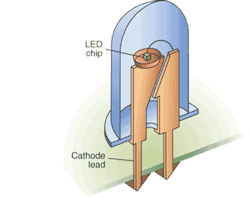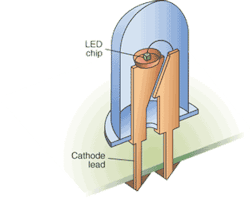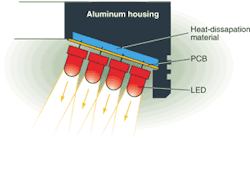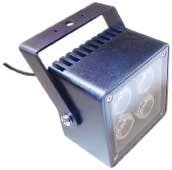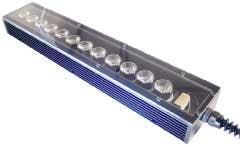LEDs and controllers speed vision inspections
High-current, high-flux LEDs enable large-area inspection, while smart electronic control systems improve high-speed inspection.
By R. Winn Hardin, Contributing Editor
Although light-emitting diodes (LEDs) were not created for machine-vision applications, lighting suppliers to the automated optical-inspection industry are getting smarter about the packaging and control of solid-state lighting systems, enabling a wider-and brighter-variety of illumination options. Unlike incandescent bulbs that heat a filament to produce light, or fluorescent or high-intensity discharge lights that use a ballast to create electron carriers and phosphor coatings to convert electrons to photons, LEDs are made from several layers of semiconducting metals that are cut into chips. Semiconductors do not have moving parts or many components, which lends a ruggedness beyond that possessed by incandescent or gas-discharge lamps.
LEDs last up to 100,000 hours and beyond, compared to 1000 hours for standard incandescent lamps, and use up to 90% less energy than conventional lights. Also, because there is no filament or gas heating prior to ignition, LEDs illuminate quicker than conventional lamps, which can ease the integration of a trigger signal with an asynchronous camera and LED lighting system in high-speed inspection systems (see Fig. 1).
FIGURE 1. LEDs typically come in discreet packages in which the LED chip is wire-bounded to a cathode and anode and encapsulated in hardened epoxy that also acts as a lens. New packaging methods include surface-mount LEDs that use solder balls and pads rather than leads and vias for mounting.
LEDs also can be tailored to produce almost any wavelength of light-including ultraviolet, white light, infrared, and visible colors-without the use of a color filter as is the case with conventional lamps. "These days, a lot of emphasis is being put on UV LEDs, whether it's for detection, identification, or excitation applications," explains Joe DiRuzza, director of sales and product management for StockerYale.
"UV lights are used to inspect dye penetrants, labels, or codes with UV-sensitive inks and to inspect glue to make sure there is a good seal on a container," says DiRuzza. Recently, Stocker Yale sold a 405-nm UV LED array into a consumer goods application that inspects laminated paper products.
Various sections are glued together at the seams to create the final product. To inspect the seams, a UV dye is included in the glue, which, when excited by the 405-nm LED array, returns a visible-light signature that can be detected by the naked eye, or in this case, a mounted CCD camera. Using a standard machine-vision system and image-processing techniques, the system automatically locates the fluorescent UV dye in the seam and analyzes the length and size of the seam to determine whether the product meets quality guidelines.
According to DiRuzza, LED manufacturers are pushing for UV LEDs with shorter wavelengths. Current devices emit around a peak wavelength of 405 nm, although 395 nm is available. UV LEDs with emissions centered around 375 nm are under development, while 365 nm is considered to be the optimal UV wavelength for many applications.
FIGURE 2. Lumileds has produced a 'warm' white LED light with 20-lumen output and color temperature of 3200 K.
White light is created by merging all visible colors. By combining red, green, and blue LEDs, or a single LED with a phosphor coating, they can also produce white light. "The white lights need more intensity with better color temperatures," comments DiRuzza. "Right now, most LEDs are blue with white phosphor. These are very high in the color temperature range-up around 7000 K-and you need to be in the 5000 K range to have a more natural white light" (see Fig. 2).
Structured-light solutions
Light from LEDs is also directional, which makes them better for structured-light solutions. According to John Thrailkill, president of Advanced Illumination, a bottling line is a good example of an inspection system that uses structured light. Using an aiming system to control the direction of the LED emission, discreet LEDs can form lighting arrays that cross the light beams at the neck of the bottle, while allowing the beams to expand inside the bottle for glass-quality inspection.
A recent high-speed bottling-inspection application called for a machine-vision solution that could locate debris inside empty glass bottles. A camera looking down inside the bottle would not have been able to see debris in the corners of the bottle, so the integrator used an Advanced Illumination SL 2420 spotlight round LED array with a Signatech intelligent electronic controller and placed the camera so that it looked horizontally at the bottle.
The LED array was designed so that the beams focused on a point 2 in. in front of the light. The light was placed 2 in. above the bottling line, pointing downward into the bottle. The beams entered the bottle through the neck and then expanded into the bottle, causing debris inside the bottle to cast shadows that were easily identified by the camera and image-processing algorithms. The Signatech controller allowed the light to be overdriven from 30 mA to 2 A, creating a strong strobe effect that helped the camera obtain clean images of the high-speed bottling line.
For these types of structured-light applications, Thrailkill continues, aiming discrete LEDs is still the best way to control the LED output for structured lighting systems. "You can't really aim LEDs as well with surface-mount technology, although surface-mount has its place, too," says Thrailkill, "especially in low-cost backlighting applications or where curved flex circuits are useful."
Large-area inspection
Although LEDs have quickly become the standard lighting for many machine-vision applications, highly efficient but low-output LEDs with emission of only a few milliwatts are inadequate for many large-area applications that need intense light sources. "The introduction of much higher-power LEDs is allowing the technology to be used for applications in the automotive and robotic [guidance] industry that in the past were impossible with LEDs," explains James O'Hanley, vice president of LED manufacturer CCS America.
FIGURE 3. Using dissipation material between the PCB and the housing, CCS America's LDR2 has substantial absorption of heat generation from the LED and efficient heat conductivity into the housing. This new construction suppresses the temperature rise of the LED sharply, thus providing stable images for a long period of time. Heat generation is cut by up to 50%.
High-current or high-flux LEDs, such as Lumileds Luxeon emitters, use multiple or larger dies and other methods to provide up to 500 mW per LED. However, "one of the hurdles that must be overcome with these new LEDs is heat management," says O'Hanley. Luxeon mounts its emitter on a copper slug to aid in heat dissipation. OEMs typically mount the Luxeon emitters on aluminum or copper plates to assist in transferring the heat from the slug to an external heat sink (see Fig. 3).
Heat can also degrade uniformity in output. According to Marcel LaFlamme, vice president of sales and marketing for RVSI/NER, maintaining appropriate operating temperature is critical to uniform brightness. To answer concerns about uniformity, OEMs are offering improved control electronics. "People are asking for fairly sophisticated controls of the light intensity and strobing, as well as multichannel control. High-flux LEDs and new controls are the big trends in the LED industry right now," says LaFlamme (see Fig. 4).
null
In recent years, control electronics shifted from driving the LED by forward voltage control to controlling the current to the LED, resulting in better temperature and light-output consistency and longer LED lifetimes. OEMs such as Advanced Illumination, CCS America, and Schott North America are offering universal and/or intelligent controllers that provide current control and more. Universal controllers typically standardize around 24 V and offer strobe capabilities, in some cases by overdriving the LED at 10% duty cycles.
Intelligent controllers can use a number of methods to monitor temperature and light output and control multiple LED array channels, in addition to controlling current, pulse length and repetition, triggering, and voltage. This can be particularly important for applications requiring tightly monitored high-flux LED arrays.
"Our intelligent controller has strobing capability and also light-feedback capability. That way we can monitor the output of the LEDs and maintain stable output during the life of the product. We also monitor temperature so that we can operate in the long-lifetime temperature range," says Tony Ruffini, director of sales and marketing for Schott North America (see Fig. 5).
FIGURE 5. Schott North America SC-2100 intelligent controller was designed for LED lighting in machine-vision applications. A microprocessor automatically recognizes the LED head type, monitors the temperature of the light through a thermistor, and ensures uniform output.
Advances such as intelligent and universal controllers are also helping to make LED lights more user-friendly. Most vendors say a custom light configuration is the best way to solve the application. This leads to low-volume production and expensive lighting systems that retard LED growth in vision-system applications. As vendors standardize around electronic controllers and move toward flexible manufacturing practices, determining and obtaining the right LED light should be easier and less costly.
"Is everything custom? Not necessarily," explains Greg Hollows, machine-vision application engineer for Edmund Industrial Optics, who uses nonsequential ray-tracing software to model machine-vision solutions with off-the-shelf components. "People who build very-high-level food-processing machines or postal sorters, for example, now have the resources to go custom [lighting]. But there are a lot of people in the second tier, such as people using vision for an automotive company, who don't have the resources to go custom. They're stuck going off-the-shelf, but often you can solve straightforward scenarios with off-the-shelf components-if you know what you're doing, " Hollows adds.
Company Info
Advanced Illumination, Rochester, VT, USA www.advancedillumination.com
CCS America, Waltham, MA, USA www.ccsamerica.com
Edmund Industrial Optics, Barrington, NJ, USA www.edmundoptics.com/vs
Lumileds Lighting, LLC, San Jose, CA, USA www.lumileds.com
RVSI/NER Weare, NH, USA www.nerlite.com
Schott North America, Auburn, NY, USA www.us.schott.com
StockerYale, Salem, NH, USA www.stockeryale.com
